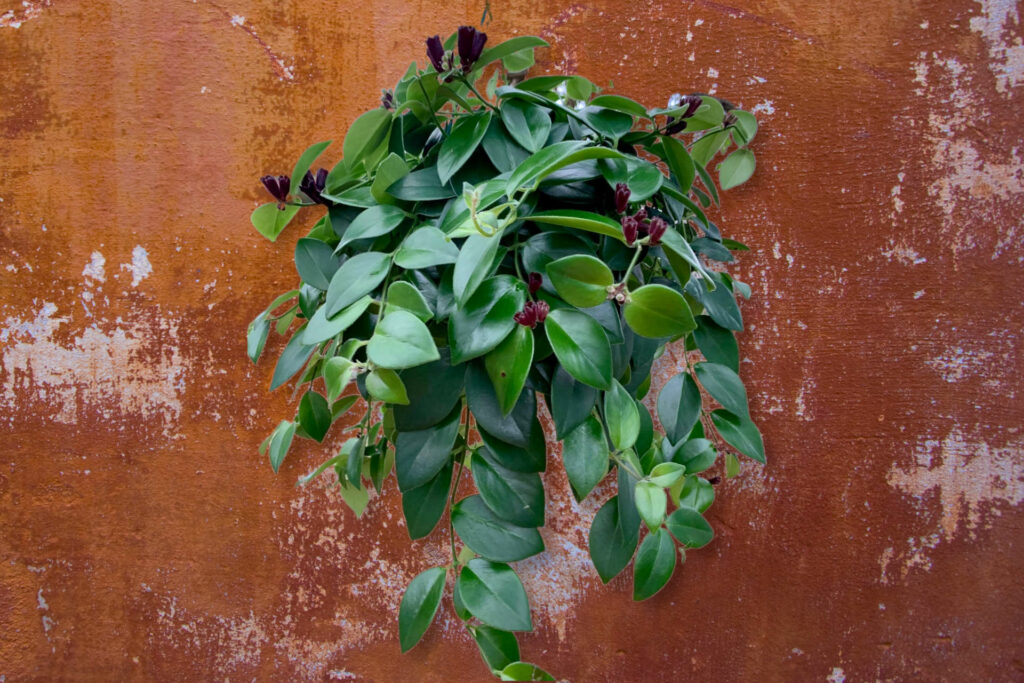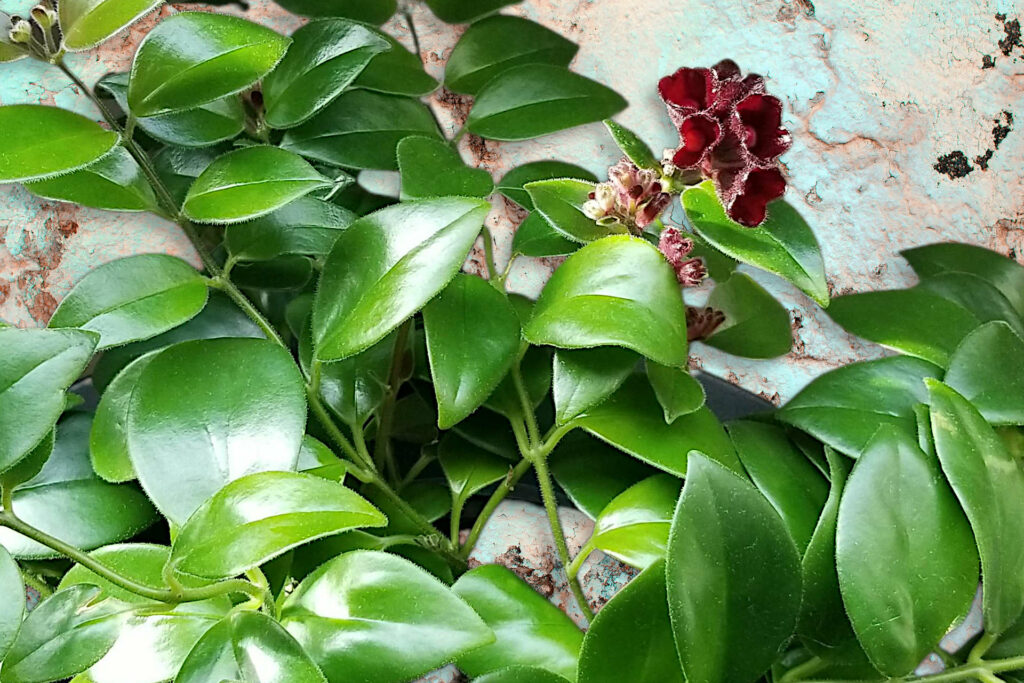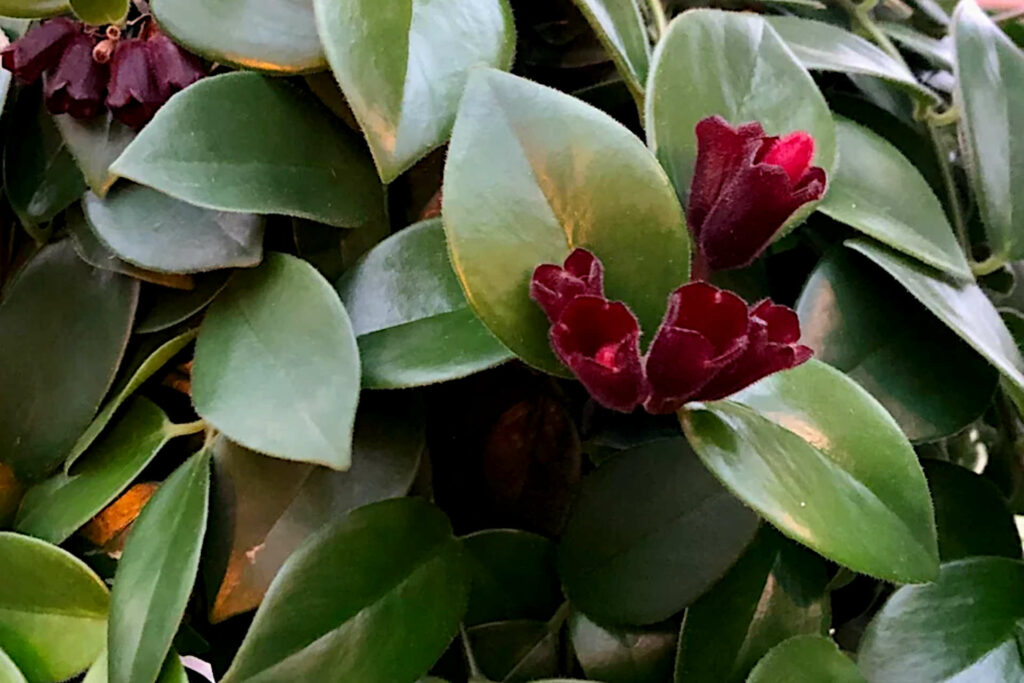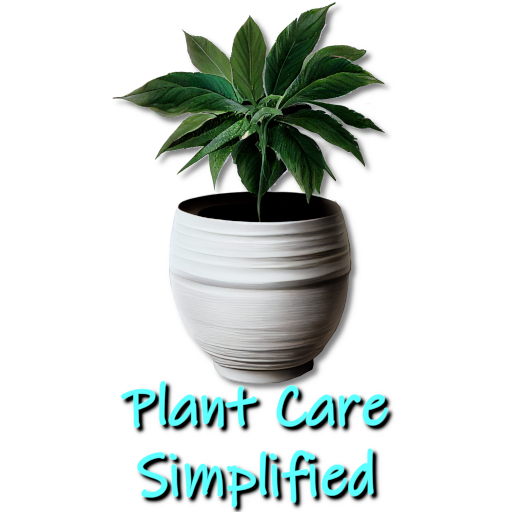Mona Lisa Lipstick Plant (Aeschynanthus speciosus): The Complete Guide
Kim is passionate about helping people create beautiful, healthy indoor spaces that are filled with plants. Kim believes that plants make us happier, healthier human...
The Mona Lisa Lipstick Plant (Aeschynanthus speciosus) is a stunning and unique variety of epiphytic plants that makes for an eye-catching houseplant. This low-maintenance tropical plant is native to Southeast Asia and features elegant cascading foliage coupled with vibrant tubular blooms making it an excellent houseplant.
Overview: Mona Lisa Lipstick Plant

Origin and Background
The Mona Lisa Lipstick Plant hails from the lush rainforests of Thailand, Malaysia, and Indonesia. Its common name is from the distinctive flowers resembling old-fashioned lipstick tubes. The Mona Lisa Lipstick plant's flowers emerge from tubular red bracts that contrast beautifully with the dark green glossy leaves. Early botanical explorers introduced This plant to Europe in the 1800s. Since then, it has become a beloved and popular indoor plant for its exotic appeal and vibrant colors.
Identifying Features
This trailing epiphyte is characterized by its slender, elongated leaves that can reach 3-5 inches in length. The foliage has an attractive shiny texture and emerges from cascading stems. During the fall and winter months, vivid reddish-pink tubular flowers unfurl from red bracts nestled within the leaves. The blooms last several weeks, providing a colorful display. This low-maintenance plant reaches 1-3 feet in trailing length and thrives with minimal care when grown as a houseplant. Its elegant foliage and showy blooms make it a striking addition to indoor plant collections.
Differing Opinions on Growing the Mona Lisa Lipstick Plant
The Mona Lisa Lipstick Plant is a unique and visually striking houseplant that has sparked some differing opinions among indoor gardeners. While some argue it's an easy plant suitable for beginners, others insist it's better left to more advanced growers. There is no doubt, however, that this plant offers vibrant color and textural interest.
"It's an Easy Houseplant for Beginners"
Some indoor gardening enthusiasts insist the Mona Lisa Lipstick Plant is a great starter plant due to its simple care needs and ability to tolerate inconsistent watering or poor lighting. Supporters of this opinion cite the following reasons:
- Thrives in medium indirect light conditions. Doesn't require intense light.
- Only needs repotting every 2-3 years. Doesn't need frequent up-potting.
- Can bounce back after bouts of underwatering or overwatering.
In general, advocates of this view feel the lipstick plant is a hardy, forgiving houseplant that's nearly impossible to kill. The lush trailing foliage and colorful blooms make it an easy, low-maintenance winner.
"It's Better Suited for Advanced Growers"
On the other side of the spectrum, some expert indoor gardeners insist the Mona Lisa Lipstick Plant is better left to more experienced hands. Reasons cited include:
- Requires consistent warm temperatures and high humidity to thrive.
- Prone to pests like mealybugs and aphids. It can be difficult to eradicate.
- Tricky to propagate from stem cuttings. Lower success rate.
Overall, this camp argues that the demand for warm, humid conditions, along with pest susceptibility, makes this plant less than ideal for new plant parents. Intermediate or advanced skills are needed to keep it happy and healthy over the long haul.
"It Offers Striking Visual Interest"
Regardless of where you stand on the care difficulty spectrum, most can agree this lipstick plant variety offers unique visual pizzazz. Reasons include:
- Trailing oval-shaped leaves create a lush cascading effect.
- Vibrant tubular blooms in shades of pink, red, and purple.
- Provides foliage texture and colorful flowers during winter months when other plants are dormant.
So while its care needs may be up for debate, the Mona Lisa Lipstick Plant's ability to provide an exotic focal point with its flowers and foliage is undisputed.
Acquiring a Healthy Mona Lisa Lipstick Plant

Once you've decided to add the visually striking Mona Lisa Lipstick Plant to your indoor garden, it's important to source a healthy specimen. Here are some tips on where to buy these plants and what to look for:
Where to Buy Mona Lisa Lipstick Plants
There are several options for procuring a Mona Lisa Lipstick Plant:
- Online retailers - Wide selection, but can't inspect plants in person
- Local nurseries - Check plants visually, but limited inventory
- Big box stores - Affordable, but plants may not be healthy
When buying online, look for sellers with strong reviews and healthy images of plants. Local nurseries may offer more size options. Big box stores have lower prices but inconsistent plant health.
Ensuring You Get a Healthy Plant
To maximize your chances of buying a thriving Mona Lisa Lipstick Plant, inspect for:
- Perky, green leaves - Avoid yellowing, browning, or wilting
- Firm, flexible stems - Watch for breakages or rotting
- White roots - No brown, mushy roots, which indicates rot
- Pest-free - Check the undersides of leaves for bugs or webs
Also, look for plants already producing flower buds or blooms. This is a good sign the plant is mature and healthy enough to flower.
Finally, once purchased, quarantine new plants away from existing indoor plants for a few weeks. This prevents the spread of any pests or diseases.
With proper selection and inspection, you can ensure your new Mona Lisa Lipstick Plant gets its indoor garden tenure off to the right start. Paying attention to signs of health will provide you with a high-quality specimen ready to showcase its vibrant trails of flowers and foliage.
Caring for the Mona Lisa Lipstick Plant
The Mona Lisa Lipstick Plant is a tropical epiphyte that requires specific care to thrive as a houseplant. Here are some key tips for meeting this plant's needs indoors:
Light Requirements
- Thrives in bright, indirect light
- East or west-facing windows are ideal
- Needs 12-14 hours of daylight
Watering Needs
- Prefers consistently moist soil
- Water when the top inch becomes dry
- Take care not to overwater
Humidity Preferences
- Native to tropical forests, the Mona Lisa Lipstick plant loves humidity
- Misting leaves periodically helps meet needs
- Use pebble trays or humidifiers nearby
Temperature Range
- Does best with temperatures of 65-80°F
- Cannot tolerate temperatures below 50°F
- Keep away from cold drafts
Fertilizer Recommendations
- Feed monthly in spring/summer with diluted liquid fertilizer
- Reduce feeding in winter months
- Look for balanced formula (20-20-20)
Pruning Tips
- Prune to control shape/size and remove dead stems
- Cut back to just above nodes to encourage bushiness
- Disinfect shears between cuts to avoid disease spread
Propagation Methods
- Propagate your Mona Lisa Lipstick plant from stem cuttings in spring/summer
- Take 4-6 inch cuttings just below nodes
- Root in water or moist potting mix
With the right care, the Mona Lisa Lipstick Plant will reward you with its cascading blooms and foliage in your indoor garden.
Troubleshooting Common Issues with the Mona Lisa Lipstick Plant

Even when provided with proper care, houseplants can sometimes develop issues. Below are some potential pests and diseases the Mona Lisa Lipstick Plant can face:
Pest Problems
Mealybugs
- Cottony white bugs on stems and leaves
- Treat with insecticidal soap or neem oil
- Isolate plants to prevent the spread
Aphids
- Green, yellow, or black soft-bodied insects
- Knock off with a strong spray of water
- Apply neem oil or insecticidal soap treatment
Diseases
Root Rot
- Caused by overwatering
- Roots turn brown and mushy
- Repot in new, well-draining soil
- Allow the plant to dry out between waterings
Environmental Stresses
Leaf Yellowing/Drooping
- It can indicate too much or too little water
- Ensure the plant is not over or under-watered
- Provide adequate humidity
Leaf Drop
- Natural during winter months
- Ensure proper temperatures year-round
- Cut back on watering in winter
Catching issues early and making appropriate adjustments in care can help get ailing Mona Lisa Lipstick Plants back on track. Be on the lookout for any signs of distress.
Displaying the Mona Lisa Lipstick Plant
The cascading nature of the Mona Lisa Lipstick Plant makes it a wonderful choice for display in hanging planters or on shelves. Here are some tips for showing off this plant to its best advantage:
Choosing Planters and Supports
- Select planters 2-4 inches wider than the root ball
- Make sure planters have drainage holes to prevent root rot
- For wall mounts, use sturdy brackets rated for the weight
- Trailing stems can be trained along trellises or other supports
- Opt for moisture-friendly supports like coco fiber or moss poles
- Wrapping stems loosely prevents breakage without strangling
Hanging Baskets
- Allows plant to cascade downward gracefully
- Position near a bright, indirect light source
- Keep the basket lightweight if suspended from the ceiling
- Choose baskets with coco liner to retain moisture
- Water adequately to keep roots moist in airflow
Shelves and Plant Stands
- Provides spotlight for training stems across the surface
- Allows the closest viewing of flowers and foliage
- Place the plant near a humidifier or pebble tray to boost moisture
- Positioning in east or west-facing windows provides ideal light for your Lipstick plant
- Use plant risers to lift shelves nearer light sources
- Rotate periodically to encourage even growth
The Mona Lisa Lipstick Plant can become a stunning focal point in any indoor garden room with the right planters and supports. Take advantage of its natural trailing habit to create a living cascade of vibrant color and texture.
Final Thoughts
The Mona Lisa Lipstick Plant is certainly a unique variety of houseplants. Its cascading habit, vibrant blooms, and lush foliage provide striking visual interest to indoor garden spaces. However, opinions differ on just how easy this plant is to grow successfully indoors.
While some tout it as an unfussy, low-maintenance houseplant suitable even for beginners, others insist its need for consistent conditions makes it better suited to more experienced plant parents. There are valid points on both sides of the discussion.
Ultimately, the Mona Lisa Lipstick Plant's stunning flowers and trails of foliage make it a tempting choice for anyone seeking to add a bold, tropical vibe to their indoor plant collection. Even novice gardeners can keep this plant happy with proper care, including plenty of bright, indirect light, regular watering, high humidity, and ideal temperatures.
Being aware of potential issues like pests and diseases allows for early intervention to get plants back on track. Displaying this trailing epiphyte in hanging planters or from elevated shelves and stands highlights its natural grace and beauty.
For plant lovers up for the challenge, the payoff of adding a Mona Lisa Lipstick Plant to your indoor garden is an exotic tropical accent piece unlike any other. With its distinctive flowers and foliage, it delivers striking colors and intriguing textures that can bring excitement to indoor plant displays.
Other Varieties
- Aeschynanthus evrardii Cassiopeia Lipstick Plant
- Black Pagoda Lipstick Plant: The Ultimate Guide
- The Unique Thai Pink Lipstick Plant (Aeschynanthus Thai Pink)
- Curly Lipstick Plant: Unraveling the Mystique of The Fascinating Twist
- Aeschynanthus Japhrolepis: The Lipstick Plant with a Shameful Secret
- The Gracilis Lipstick Plant: The Perfect Houseplant
- The Showy Lipstick Plant (Aeschynanthus speciosus)
Kim is passionate about helping people create beautiful, healthy indoor spaces that are filled with plants. Kim believes that plants make us happier, healthier human beings, and she loves sharing her knowledge with others so they can experience the joys of plant care for themselves. <a href="https://plantcaresimplified.com/kim-marson/">Read more</a>
More Posts